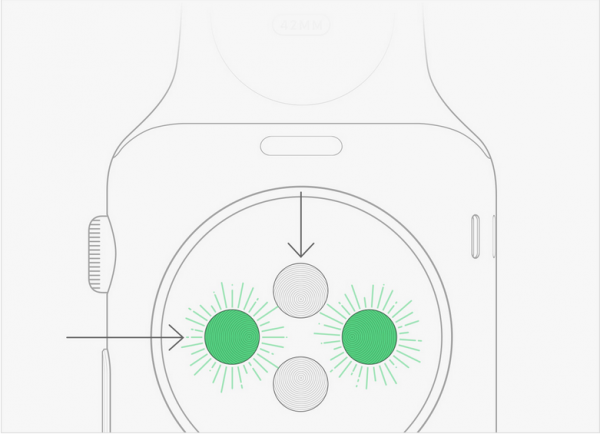A few days ago, iFixit many interested things about the Apple Watch, from the internal hardware design of Apple Watch, to a tiny battery with 205 mAh capacity , Apple S1 chip which is planted inside. One of the interesting things is the heart rate sensor technology, used in the Apple Watch. Apple explains the details how the Apple Watch measures your heart rate, and you can check that out on their website:

“The heart rate sensor in Apple Watch uses what is known as photoplethysmography. This technology, while difficult to pronounce, is based on a very simple fact: Blood is red because it reflects red light and absorbs green light. Apple Watch uses green LED lights paired with light‑sensitive photodiodes to detect the amount of blood flowing through your wrist at any given moment. When your heart beats, the blood flow in your wrist — and the green light absorption — is greater. Between beats, it’s less. By flashing its LED lights hundreds of times per second, Apple Watch can calculate the number of times the heart beats each minute — your heart rate.
The heart rate sensor can also use infrared light. This mode is what Apple Watch uses when it measures your heart rate every 10 minutes. However, if the infrared system isn’t providing an adequate reading, Apple Watch switches to the green LEDs. In addition, the heart rate sensor is designed to compensate for low signal levels by increasing both LED brightness and sampling rate.”

The rumors which circulated were about the measurement of blood oxygen as the part of the Apple’s experiment, but according to iFixit via Macrumors, Apple abandoned this option:
First, it may simply be that the company hasn’t yet achieved the necessary accuracy and reliability from the sensor. If this is indeed the case, we’ll need to wait for a second- or third-generation Apple Watch to take advantage of this capability.
But it may also be that Apple is awaiting FDA approval of this usage of the sensor. If that turns out to be true, then it’s possible that a software update could later enable the feature for existing first-gen Apple Watch owners.
I believe Apple will add this to their second Gen Apple Watch!
See also: Apple Watch Battery Life Detail and Exchange Battery Program




